Lenovo Yoga Tab 3 Plus and Miix 510 Hands-on Impressions

The updated Yoga Tab 3 Plus introduced at IFA in Berlin retains the line’s signature utilitarian design with the barrel hinge. This year’s Yoga Tab Plus marries the affordable price from last year’s Yoga Tab 3 along with the power and performance from the line’s Yoga Tab 3 Pro, which we reviewed.
If you’ve been a fan of Lenovo’s barrel design — a feature that aids with ergonomics when holding the tablet in portrait mode and helps provide endurance by cramming a large, cylindrical battery into an otherwise slim slate — then the Yoga Tab 3 Plus will impress, especially considering its starting price. Starting at $299, the Yoga Tab 3 Plus is $100 cheaper than Apple’s iPad Air 2 and Samsung’s 9.7-inch Galaxy Tab S2 after discounts.
Design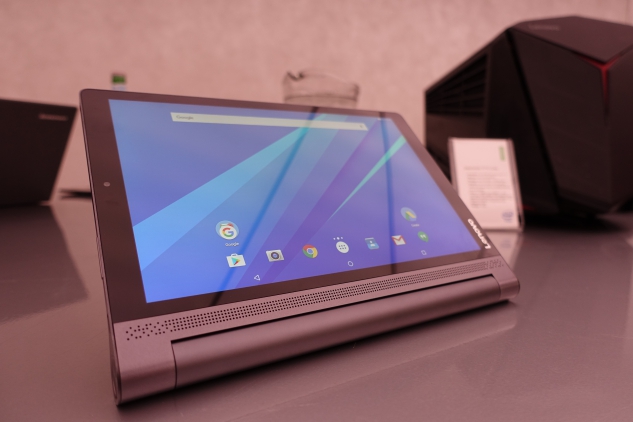 With slimmer bezels than the standard 10-inch Tab 3, the Plus model matches the design of the flagship Pro model. Both tablets come with a cylindrical barrel — which houses a large battery, four JBL speaker array, a built-in kick-stand that offers a variety of viewing modes in the rear — faux leather trim, black metal construction and a spacious 10-inch 2K display.
With slimmer bezels than the standard 10-inch Tab 3, the Plus model matches the design of the flagship Pro model. Both tablets come with a cylindrical barrel — which houses a large battery, four JBL speaker array, a built-in kick-stand that offers a variety of viewing modes in the rear — faux leather trim, black metal construction and a spacious 10-inch 2K display.
The main aesthetic difference between the Plus and the Pro model is that the Plus model does not come with the integrated pico projector module. The move allows Lenovo to offer virtually identical power, performance and design from the Pro model at a significantly lower price.
Compared to the standard Tab 3, the thinner bezels framing the display not only makes the Plus and Pro models look sleeker, but it also helps to make the tablet easier to hold and maneuver.
 After having used several generations of Lenovo’s Android-powered Yoga Tab line, I have grown fond of the built-in kickstand, and I am glad that the feature is present on the Tab 3 Plus. Like the Pro, the metal kickstand is activated via a button on the rear of the tablet. Activating the button unlatches the kickstand, and you’ll have to use your fingers and a bit of force to open the kickstand.
After having used several generations of Lenovo’s Android-powered Yoga Tab line, I have grown fond of the built-in kickstand, and I am glad that the feature is present on the Tab 3 Plus. Like the Pro, the metal kickstand is activated via a button on the rear of the tablet. Activating the button unlatches the kickstand, and you’ll have to use your fingers and a bit of force to open the kickstand.
The kickstand does a great job holding the tablet upright for viewing on a flat surface, like on a desk or tablet. On the Pro model, I found that the kickstand’s short lip had trouble balancing the tablet when I was trying to stand it on a softer surface, like a bed or couch, and I imagine that the Plus model will encounter the same issue given the design similarities.
There is also a notch in the kickstand, which is useful for hanging the tablet up on a wall. To do this, the kickstand must be fully opened so that it forms approximately a 180-degree angle with the slate. Lenovo reps told me that the notch design is inspired from wooden cutting boards in the kitchen, and this mode would allow you to watch your favorite cooking videos or catch up on Netflix while you’re preparing a savory meal.
Other modes that you can use the kickstand in would be stand mode, for lean-back media consumption. You can also use the kickstand for tilt mode, for lean-in content creation. Tilt mode props the screen of the tablet up a comfortable angle, which would also be useful for pecking out a lengthy email using the tablet’s on-screen keyboard.
The tablet comes with a 5-megapixel front-facing camera and a 13-megapixel autofocus rear camera.
Multimedia The highlight of the tablet is entertainment, and Lenovo’s thoughtful consideration of hardware features will keep you immersed in video and audio content.
The highlight of the tablet is entertainment, and Lenovo’s thoughtful consideration of hardware features will keep you immersed in video and audio content.
-

-

-

-

- Curated Home Page Articles By Test Admin October 21, 2025 | 3:10pm
-

- Curated Home Page Articles By Test Admin October 21, 2025 | 2:57pm
- Urls By Test Admin October 21, 2025 | 2:57pm
- Curated Home Page Articles By Test Admin October 21, 2025 | 2:55pm
-

-

-

-

-

-

-

-

-

-

-

-

-

-

-

-

-

-

-

-

-

-

-

-

-

-

-

-

-

-

-

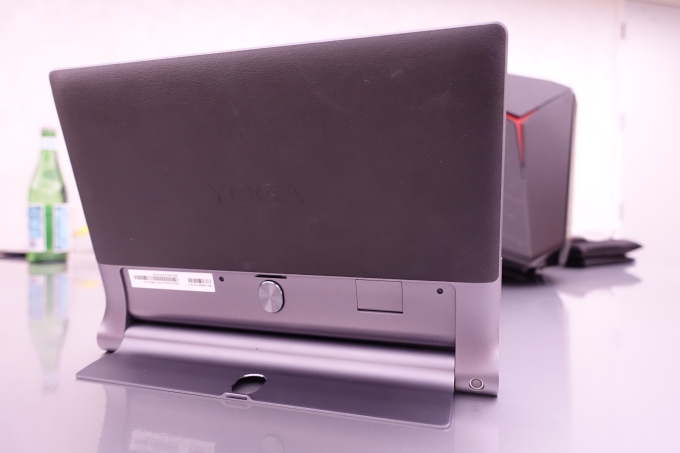 Because Intel’s recent change in strategy by shifting away from mobile, Lenovo executives told me that they had to move away from the Atom processor on then Pro model to an ARM architecture chipset on the Plus.
Because Intel’s recent change in strategy by shifting away from mobile, Lenovo executives told me that they had to move away from the Atom processor on then Pro model to an ARM architecture chipset on the Plus.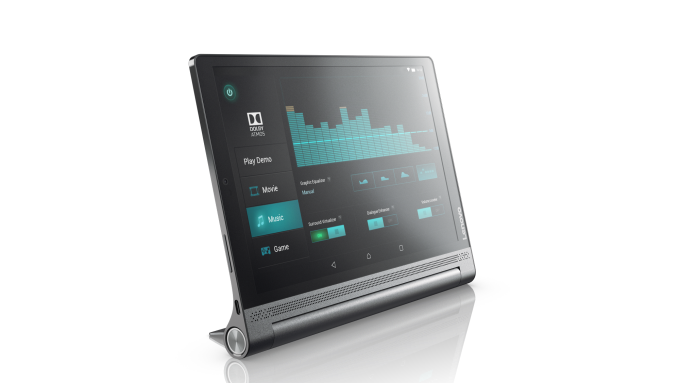 From my hands-on time with the tablet, it handled most tasks well, and I didn’t experience any lags or stutters. We’ll have to test the Plus model with games to see how it performs with graphics-heavy tasks.
From my hands-on time with the tablet, it handled most tasks well, and I didn’t experience any lags or stutters. We’ll have to test the Plus model with games to see how it performs with graphics-heavy tasks. Lenovo brings the power, performance and design from its Yoga Tab 3 Pro model at a much more affordable price point with the introduction of the Yoga Tab 3 Plus. From its barrel hinge, integrated kickstand and front-facing speaker bar, the Yoga Tab 3 Plus essentially mirrors its premium sibling, but eschews the built-in projector and sheds $200 off the price.
Lenovo brings the power, performance and design from its Yoga Tab 3 Pro model at a much more affordable price point with the introduction of the Yoga Tab 3 Plus. From its barrel hinge, integrated kickstand and front-facing speaker bar, the Yoga Tab 3 Plus essentially mirrors its premium sibling, but eschews the built-in projector and sheds $200 off the price.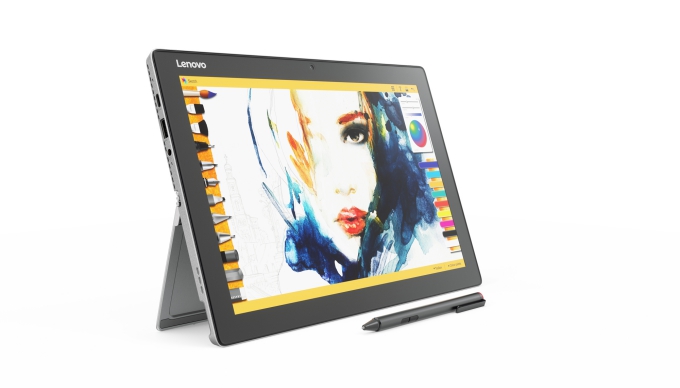 If you’re mourning the end of Microsoft’s more affordable Surface 3 tablet, Lenovo has you covered. At IFA, the company unveiled the Miix 510, a convertible tablet that integrates the best features of the Surface 3 into an even more powerful mobile computing experience.
If you’re mourning the end of Microsoft’s more affordable Surface 3 tablet, Lenovo has you covered. At IFA, the company unveiled the Miix 510, a convertible tablet that integrates the best features of the Surface 3 into an even more powerful mobile computing experience. To keep costs in check, Lenovo went with a metallic finish on the Miix 510, rather than pure metal construction like on the competing Microsoft Surface 3, HP Spectre x2 or the recently reviewed
To keep costs in check, Lenovo went with a metallic finish on the Miix 510, rather than pure metal construction like on the competing Microsoft Surface 3, HP Spectre x2 or the recently reviewed 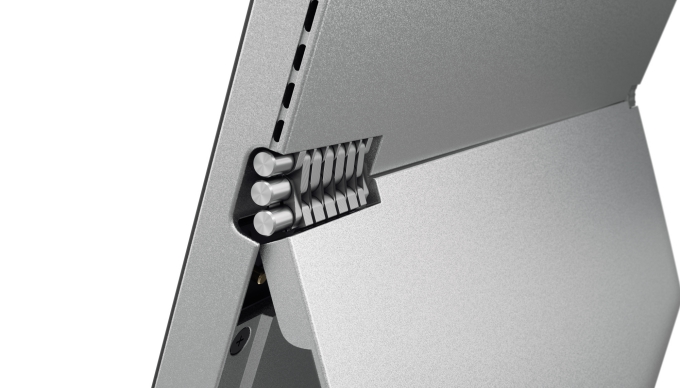 Depending on how you’re looking at the difference in screen size, this bump in dimension could either make the Miix 510 less portable or more productive. With its screen size, the Miix 510 is more comparable to Microsoft’s Surface Pro 4, but with the resolution of the Surface 3. The Miix 510’s screen resolution and size is similarly shared by HP’s Spectre x2, but HP’s model comes with Intel’s mid-range Core m series processors rather than the mainstream Core i series. All the referenced tablets share the same 3:2 aspect ratio, which makes the tablet nice for reading documents when held in portrait orientation.
Depending on how you’re looking at the difference in screen size, this bump in dimension could either make the Miix 510 less portable or more productive. With its screen size, the Miix 510 is more comparable to Microsoft’s Surface Pro 4, but with the resolution of the Surface 3. The Miix 510’s screen resolution and size is similarly shared by HP’s Spectre x2, but HP’s model comes with Intel’s mid-range Core m series processors rather than the mainstream Core i series. All the referenced tablets share the same 3:2 aspect ratio, which makes the tablet nice for reading documents when held in portrait orientation.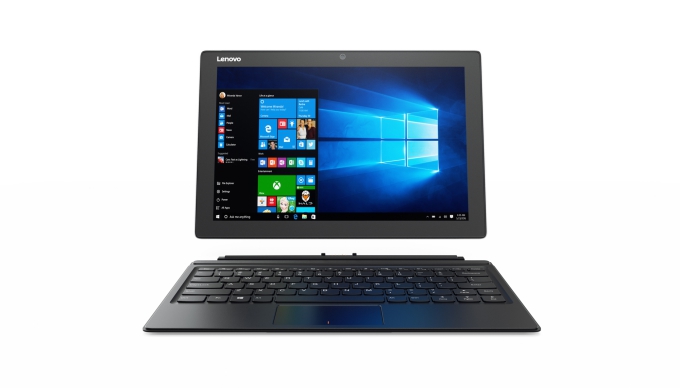 Unfortunately, the Miix 510 wasn’t delivered in time for my meeting with Lenovo in San Francisco ahead of its IFA unveiling, so I didn’t get to spend time with the keyboard for impressions. However, given Lenovo’s heritage with ThinkPad keyboard designs and the advertised 1.5mm of key travel, I expect this keyboard to perform well, especially when compared against the Surface Pro 4’s Type Cover, which offers a more shallow 1.3mm of travel.
Unfortunately, the Miix 510 wasn’t delivered in time for my meeting with Lenovo in San Francisco ahead of its IFA unveiling, so I didn’t get to spend time with the keyboard for impressions. However, given Lenovo’s heritage with ThinkPad keyboard designs and the advertised 1.5mm of key travel, I expect this keyboard to perform well, especially when compared against the Surface Pro 4’s Type Cover, which offers a more shallow 1.3mm of travel.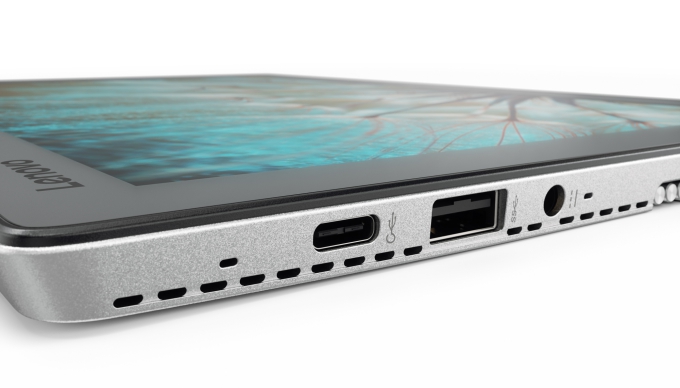 One of the most requested features on Microsoft’s premium Surface Pro range that is only available on the entry-level Surface 3 is the inclusion of a mobile broadband radio.
One of the most requested features on Microsoft’s premium Surface Pro range that is only available on the entry-level Surface 3 is the inclusion of a mobile broadband radio.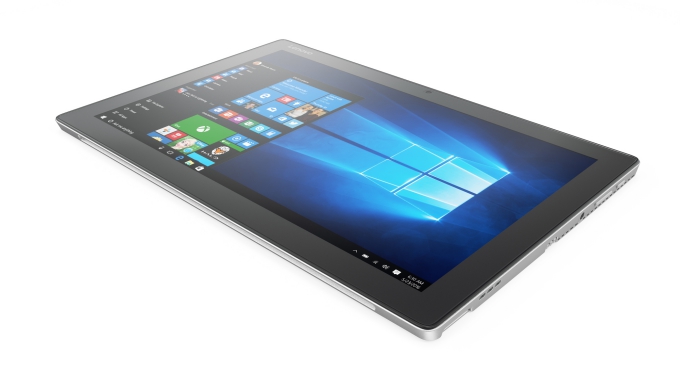 Lenovo says that the tablet has a battery life of 7.5 hours, but we’ll have to test these claims when we receive a review unit.
Lenovo says that the tablet has a battery life of 7.5 hours, but we’ll have to test these claims when we receive a review unit.


































